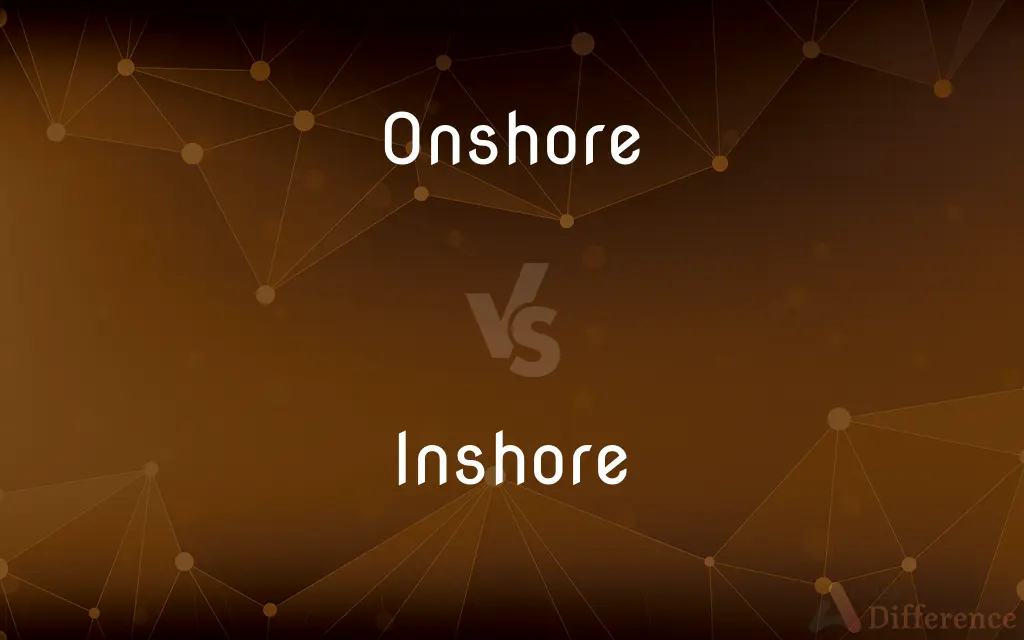Onshore vs. Inshore — What's the Difference?
By Fiza Rafique & Maham Liaqat — Updated on March 26, 2024
Onshore refers to activities or locations on land, especially within a country's borders, while inshore denotes areas close to the shore, particularly in a maritime context.

Difference Between Onshore and Inshore
Table of Contents
ADVERTISEMENT
Key Differences
Onshore activities are typically associated with industries such as onshore oil drilling, wind farms, and business processes that occur within a country's borders. These activities are land-based and can impact a country's economy and environment significantly. On the other hand, inshore relates to maritime activities occurring near a coast, within a certain distance from the shore, often involving fishing, boating, and marine research. This term is crucial for categorizing areas for marine navigation, fishing regulations, and environmental protection efforts.
In terms of location, onshore refers to the interior parts of a country, away from the coastal regions. It involves operations and activities that take place on the mainland, such as agriculture, manufacturing, and inland tourism. Whereas inshore describes areas that are close to the land but within a body of water, usually extending a few miles from the coastline. This proximity to land influences the biodiversity, marine conditions, and activities that can be conducted in inshore waters.
Environmental considerations also differ between onshore and inshore. Onshore activities, especially industrial ones like mining or drilling, are often scrutinized for their environmental impact on terrestrial ecosystems. Measures are taken to mitigate soil contamination, deforestation, and air pollution. In contrast, inshore areas face challenges like water pollution, habitat destruction, and overfishing. Environmental protection efforts in these areas focus on maintaining water quality and preserving coastal and marine ecosystems.
Economically, onshore developments contribute to a variety of sectors including real estate, agriculture, and industry. They are pivotal in shaping the economic landscape of a country's interior. Inshore areas, however, have a significant impact on economies through maritime activities such as coastal tourism, fishing industries, and port operations. Both onshore and inshore developments require careful planning and management to balance economic growth with environmental sustainability.
The regulatory frameworks governing onshore and inshore activities also differ, reflecting the unique challenges and priorities of each domain. Onshore regulations might address land use, industrial emissions, and workplace safety, among others. Inshore regulations, however, focus on maritime safety, fishing quotas, and marine conservation areas. These legal frameworks are essential for managing the impacts of human activities and ensuring the sustainable use of natural resources.
ADVERTISEMENT
Comparison Chart
Location
Activities or locations on land, within a country.
Areas close to the shore, within a body of water.
Industries
Oil drilling, wind farms, agriculture, manufacturing.
Fishing, boating, marine research.
Environmental Impact
Affects terrestrial ecosystems, air, and soil.
Impacts marine ecosystems, water quality.
Economic Contribution
Contributes to land-based sectors like agriculture.
Supports maritime activities, coastal tourism.
Regulatory Focus
Land use, industrial emissions, workplace safety.
Maritime safety, fishing quotas, marine conservation.
Compare with Definitions
Onshore
Concerning business processes located within a country.
Many firms are considering onshore options for their IT departments.
Inshore
Referring to areas close to the shore, within a maritime context.
Inshore fishing provides a livelihood for many coastal communities.
Onshore
Pertaining to land-based activities within a country's borders.
The company is investing in onshore wind farms to boost renewable energy production.
Inshore
Concerned with navigation or operations within a few miles of the shore.
Inshore navigation requires careful attention to avoid shallow waters.
Onshore
Relating to operations conducted on the mainland.
Onshore manufacturing has seen a resurgence due to changing economic policies.
Inshore
Involving marine activities near the coastline.
The inshore waters are popular for recreational boating and fishing.
Onshore
Associated with the interior part of a country.
Onshore natural reserves are crucial for the country's biodiversity.
Inshore
Related to the regulatory and conservation efforts of coastal areas.
Inshore marine conservation areas help protect endangered species.
Onshore
Involving the extraction of natural resources from land areas.
Onshore oil drilling operations have raised environmental concerns.
Inshore
Pertaining to the marine environment close to land.
Inshore coral reefs are vital habitats for diverse marine species.
Onshore
Moving or directed toward the shore
An onshore wind.
Inshore
Close to a shore.
Onshore
Located on the shore
An onshore beacon.
An onshore patrol.
Inshore
Toward or coming toward a shore.
Onshore
Toward the shore
The wind shifted onshore.
Inshore
Close to (especially in sight of) a shore.
Onshore
Moving from the sea towards the land.
An onshore breeze
Inshore
(of a wind) Blowing from the sea to the land.
Onshore
Positioned on or near the shore.
Inshore
Near the shore.
Onshore
Within the country; not overseas.
Inshore
Towards the shore.
Onshore
From the sea towards the land.
Inshore
Being near or moving towards the shore; as, inshore fisheries; inshore currents.
Onshore
(management) To relocate production, services or jobs to lower-cost locations in the same country.
Inshore
(of winds) coming from the sea toward the land;
An inshore breeze
An onshore gale
Seaward winds
Onshore
Coming from the sea toward the land; - of winds and weather; as, an onshore gale. Opposed to offshore.
Inshore
Close to a shore;
Inshore fisheries
Onshore
On the edge of the land; near the shoreline; as, an onshore lighthouse.
Inshore
Toward the shore;
We swam two miles inshore
Onshore
(of winds) coming from the sea toward the land;
An inshore breeze
An onshore gale
Seaward winds
Onshore
On the edge of the land;
An onshore lighthouse
Onshore
On or toward the land;
They were living onshore
Common Curiosities
What is the focus of regulations for onshore and inshore areas?
Regulations focus on managing land use and environmental impacts for onshore areas, and maritime safety and conservation for inshore areas.
What is the significance of inshore areas?
Inshore areas are significant for maritime activities, environmental conservation, and coastal communities, often extending a few miles from the coastline.
Can both onshore and inshore activities contribute economically?
Yes, both contribute economically through different sectors: onshore through land-based industries and inshore through maritime activities and tourism.
How does the location of onshore activities compare to inshore?
Onshore activities occur on land within the interior of a country, while inshore activities are near the coastline within maritime waters.
What defines onshore activities?
Onshore activities are those conducted on land, particularly within a country's borders, including industrial, agricultural, and business operations.
How do environmental impacts differ between onshore and inshore?
Onshore activities impact terrestrial ecosystems and air quality, while inshore activities affect marine ecosystems and water quality.
Are inshore waters important for biodiversity?
Yes, inshore waters are crucial for marine biodiversity, providing habitats for a wide range of species.
How do onshore developments impact the economy?
Onshore developments impact the economy by contributing to various sectors, including industrial, agricultural, and energy production.
Can inshore activities influence local communities?
Yes, inshore activities, especially fishing and tourism, play a vital role in the livelihoods and economies of local coastal communities.
How do inshore and onshore areas contribute to environmental sustainability?
Both areas contribute by providing resources and opportunities for conservation efforts, though they face different environmental challenges.
What industries are commonly found in onshore locations?
Industries such as oil drilling, agriculture, and manufacturing are commonly found in onshore locations.
Why are inshore areas regulated differently from onshore areas?
Inshore areas are regulated differently due to their unique maritime environment, focusing on marine conservation and fisheries management.
What role do onshore activities play in renewable energy?
Onshore activities, such as wind and solar farms, are pivotal in the production of renewable energy.
Are there specific challenges in managing inshore waters?
Yes, managing inshore waters involves addressing challenges like pollution, overfishing, and habitat degradation.
Share Your Discovery

Previous Comparison
Aura vs. Vibe
Next Comparison
Ail vs. IllAuthor Spotlight
Written by
Fiza RafiqueFiza Rafique is a skilled content writer at AskDifference.com, where she meticulously refines and enhances written pieces. Drawing from her vast editorial expertise, Fiza ensures clarity, accuracy, and precision in every article. Passionate about language, she continually seeks to elevate the quality of content for readers worldwide.
Co-written by
Maham Liaqat















































